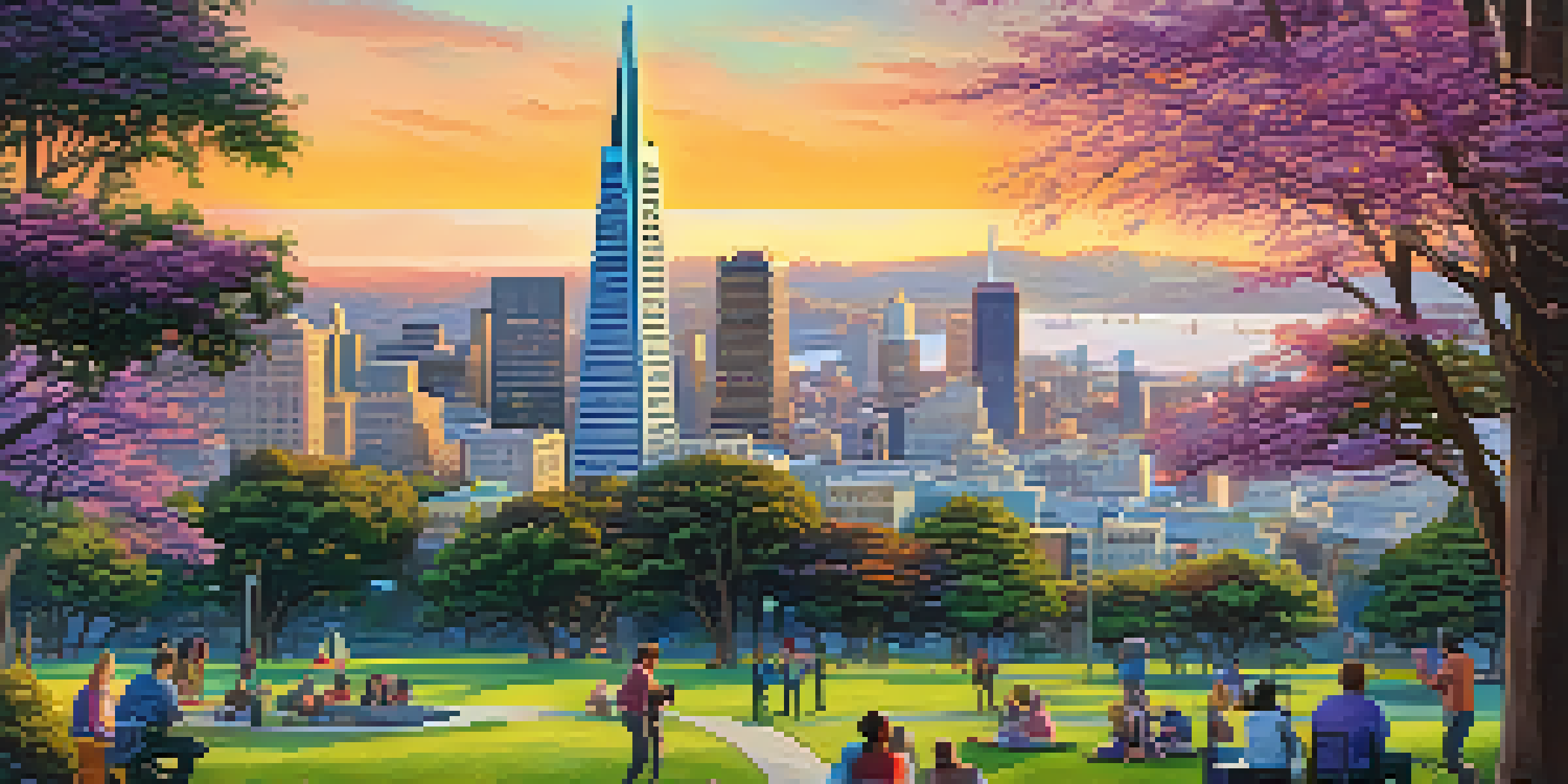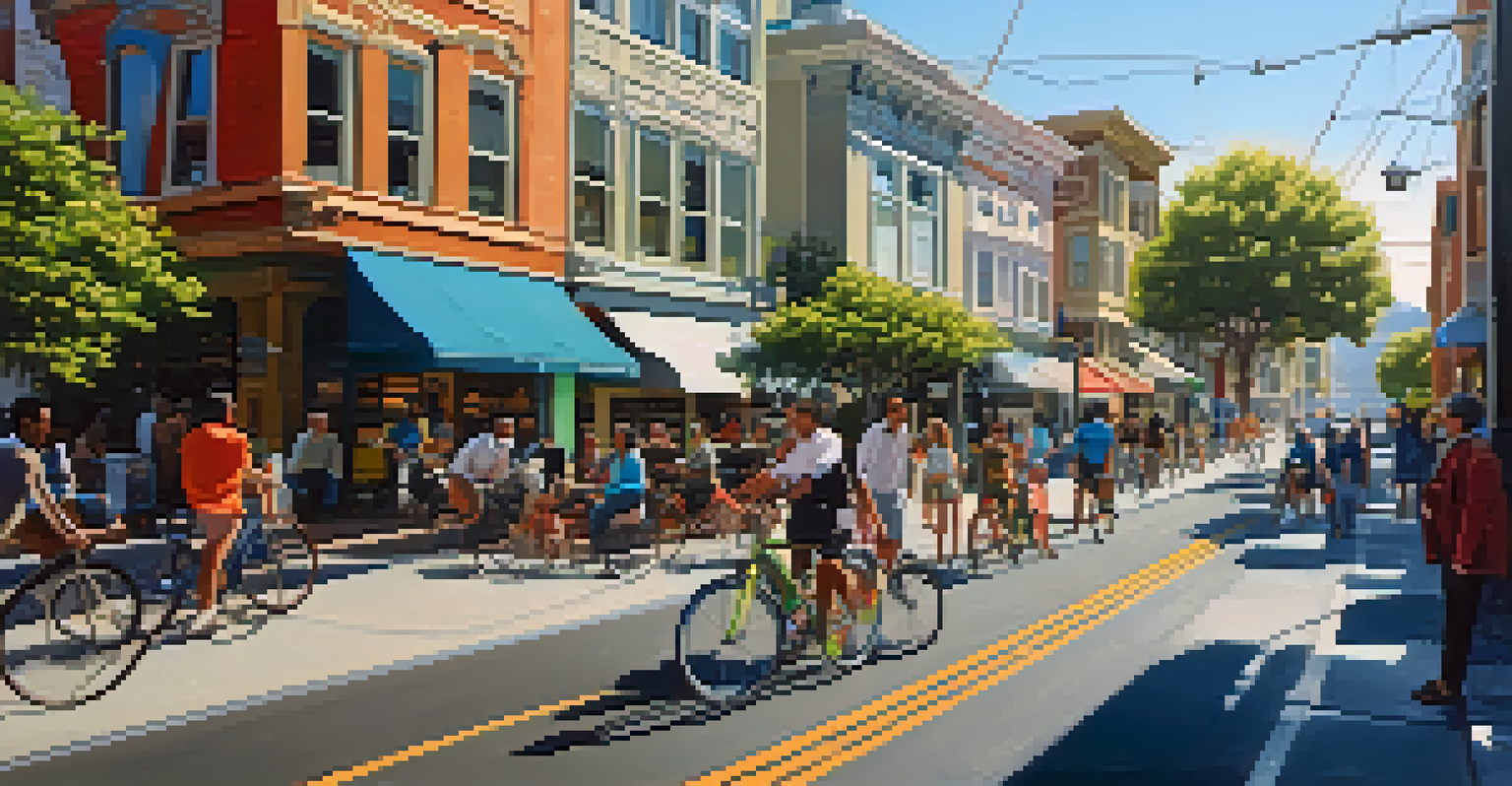Impact of Tech Industry on San Francisco's Urban Landscape

Tech Boom: A Catalyst for Urban Transformation
The tech boom in San Francisco has undeniably transformed the urban landscape. With the influx of tech companies, the city has experienced a surge in development, leading to new skyscrapers and office spaces that redefine its skyline. These changes not only reflect the growth of the industry but also indicate a shift in the city’s identity, as it evolves from a historical hub into a modern tech metropolis.
The greatest danger in times of turbulence is not the turbulence; it is to act with yesterday's logic.
As tech giants set up shop, neighborhoods have adapted, often prioritizing tech-centric amenities. For instance, the Mission District has seen a rise in gourmet coffee shops and co-working spaces, catering to the needs of tech professionals. This shift brings a unique vibrancy but also raises questions about gentrification and the displacement of long-time residents.
Moreover, the architectural style of new buildings often mirrors the innovative spirit of the tech companies they house. Sleek designs and sustainable materials are becoming the norm, showcasing a commitment to both modernity and environmental consciousness. This transformation highlights how the tech industry's values are deeply intertwined with the physical space it occupies.
Housing Challenges Amidst Rapid Growth
As the tech industry flourishes, so too do the challenges related to housing in San Francisco. The demand for housing has skyrocketed, leading to increased prices that many residents find prohibitive. This situation often forces individuals and families to seek homes further from the city, which can disrupt community ties and contribute to longer commutes.

The response to this housing crisis has sparked significant discussions about urban planning and policy. Local governments and tech companies are now exploring solutions, such as affordable housing initiatives and zoning changes. However, balancing the needs of newcomers and existing residents remains a delicate task, often met with mixed reactions.
Tech Boom Reshapes Urban Landscape
The influx of tech companies in San Francisco has transformed its skyline and neighborhood dynamics, raising concerns about gentrification.
Additionally, the creation of new housing projects often faces resistance from communities concerned about preserving their neighborhoods' character. As a result, the conversation around housing is not just about numbers; it's about the heart and soul of San Francisco, which continues to evolve in response to the tech industry’s growth.
Public Transportation: Adapting to New Demands
The increase in tech workers has put immense pressure on San Francisco's public transportation system. With more people commuting from surrounding areas, services like BART and Muni have had to adapt to handle the surge in ridership. This evolving landscape has sparked discussions about improving efficiency and expanding service to meet the needs of the growing population.
Sustainable development is the pathway to the future we want for our children and grandchildren.
In response, San Francisco has launched initiatives aimed at enhancing public transit options. These include investments in infrastructure upgrades and the introduction of new routes to better connect tech hubs with residential neighborhoods. Such efforts are crucial in reducing traffic congestion and promoting a more sustainable urban environment.
Moreover, the rise of tech companies has also led to the emergence of shuttle services, often provided by the companies themselves. These services cater to employees, connecting them directly from their homes to their workplaces. While this may alleviate some pressure from public transport, it also raises questions about equity and accessibility for all San Franciscans.
Green Spaces: Balancing Urban Development
As San Francisco's tech industry expands, the preservation and creation of green spaces have become increasingly important. Urban parks and recreational areas offer a necessary respite from the bustling city life and are vital for community well-being. However, the pressure to develop land for new offices and housing often threatens these cherished spaces.
Efforts to integrate green infrastructure into urban development have gained momentum. Projects that include parks, gardens, and green roofs are being prioritized to create a more balanced urban environment. This approach not only enhances the city's aesthetics but also contributes to improved air quality and biodiversity.
Housing Crisis Challenges Residents
Rapid tech growth has led to skyrocketing housing prices, forcing many residents to move further from the city and disrupting community ties.
Moreover, community initiatives often advocate for the enhancement of existing green spaces. These grassroots movements emphasize the importance of maintaining accessible areas for public enjoyment, ensuring that as the city evolves, it retains its natural beauty and provides a refuge for all its residents.
Cultural Shifts: The Intersection of Tech and Community
The arrival of the tech industry in San Francisco has sparked cultural shifts that are reshaping community dynamics. New residents bring fresh perspectives, ideas, and social activities that can enrich the local culture. However, this influx can sometimes overshadow long-standing traditions and practices unique to the city.
Events like tech meetups and hackathons exemplify how the industry fosters collaboration and innovation, often attracting diverse groups. Yet, this cultural blending can lead to tension, as original residents may feel alienated or overlooked in their own neighborhoods. Finding common ground is essential in maintaining the unique identity of San Francisco.
As tech and community identity continue to evolve, there is potential for a symbiotic relationship. By embracing diversity and encouraging dialogue between newcomers and long-time residents, the city can create a vibrant culture that honors its history while embracing the future.
Economic Impact: Jobs and Opportunities
The tech industry's growth has significantly impacted San Francisco's economy, creating a wealth of job opportunities across various sectors. From software development to marketing and sales, the demand for skilled workers has risen dramatically. This influx of jobs attracts individuals from all over the world, contributing to a dynamic and diverse workforce.
However, this economic boom also comes with challenges. While many benefit from these new opportunities, there are concerns about job security and wage disparities. The disparity between high-paying tech jobs and lower-wage positions in other sectors can create economic divides within the city.
Sustainability Drives Future Development
As the tech industry evolves, there is a growing emphasis on eco-friendly practices and community involvement in urban planning.
Additionally, the concentration of wealth generated by the tech industry has raised questions about responsible business practices and community contributions. As companies thrive, there is an increasing call for them to give back to the community, addressing issues such as affordable housing and education, thus ensuring that the economic benefits are felt by all residents.
Future Outlook: Sustainability in Urban Development
Looking ahead, the sustainability of San Francisco's urban landscape is a key concern as the tech industry continues to grow. There is a growing consensus that future developments must prioritize eco-friendly practices and social responsibility. This includes everything from energy-efficient buildings to community engagement in planning processes.
Tech companies are increasingly recognizing their role in fostering sustainable practices. Many are investing in green technologies and initiatives that not only benefit their operations but also contribute positively to the environment. This shift towards sustainability indicates a growing awareness of the long-term impacts of urban development on both the city and its residents.

Ultimately, the future of San Francisco's urban landscape will depend on collaboration among tech companies, local governments, and communities. By working together, they can ensure that the city remains a vibrant, inclusive, and sustainable environment, effectively blending innovation with tradition.